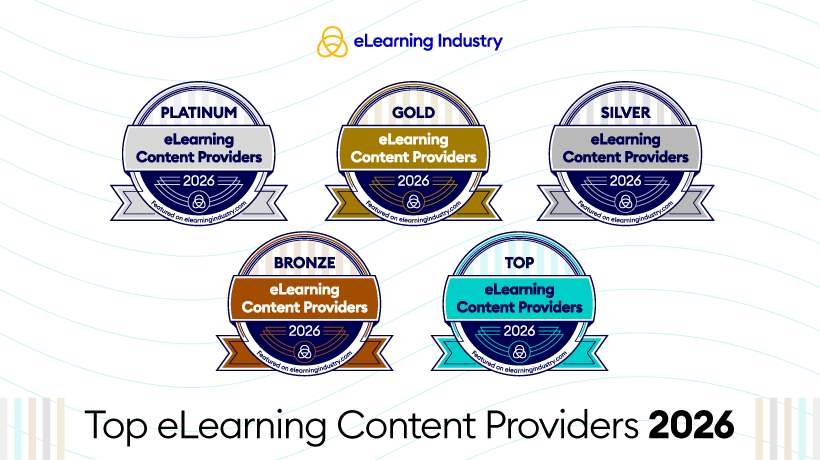eLearning Content Creation: Best Techniques
Start by noting down all the key learning objectives that exist, and then curate the required information into a concise package: You are then ready to create eLearning content. You next task is to enter all of your information into a suitable medium that you craft into a learning tool. Here are 5 techniques you need to incorporate into your eLearning content creation process in order to succeed.
1. Use Performance Objectives
“The key to making your students' learning experiences worthwhile is to focus your planning on instructional goals that are phrased in terms of desired student outcomes.” - From Motivating Students to Learn, By Kathryn R. Wentzel and Jere E. Brophy (Page 83).
Give your students something to strive for. Think about Karate lessons and how you have to work your way up from a white belt to a black belt. Even if your eLearning content doesn’t have an interactive element where learners may earn points, you may still create performance objectives that allow viewers/users to grade and score themselves.
You Can Openly State A Performance Objective.
For example, if you have designed a podcast to that teaches a foreign language, you may start the podcast with a statement such as “By the end of this podcast, you will be able to enter a French restaurant, order your meal, pay your bill, and leave while only speaking in French”. That is the performance objective that users may achieve if they pay attention and do their best to learn while listening to your podcast.
Performance Objectives Make Giving Feedback Easier.
If you are setting up an eLearning course where a tutor (or yourself) is actively involved with students, then performance objectives will also allow you the opportunity to give feedback to your students. UK assignment help often advise students to hand in their paper far in advance of deadlines (a performance objective), to encourage better and quicker feedback from their professor.
2. Consider "What's In It For Me"
Remember when you were a kid and your parents said that if you eat your spinach you will grow up big and strong, and if you eat carrots you will be able to see better? Knowing your student’s motivation for learning is okay, but giving them a motivation is also a good idea.
For every piece of information you create and for every piece of media you perfect, go back and ask yourself what is in it for your student. It can be very tricky, especially if you are not 100% what the answer is.
If you are teaching history, you may tell your students that what they learn will help them become better critical thinkers. Tell students who are learning about percentages that they will need them one day if they wish to become successful businesspersons.
Show Your Students The Positive Results That Come Through Studying.
A small team from CareersBooster were asked to analyze and verify a study by the University of Amsterdam that supposedly proved how taking frequent breaks helps improve productivity. As an indirect result, six people from the small team of ten became the top six earners in the writing company because of what they learned. Their management team asked that their other writers study the work of students at the University of Amsterdam, and many of the writers did because they had seen the benefit it had on their fellow writers.
Give Your Students Examples Of How Your Content Will Help Them.
If your students roll their eyes at the sight of yet another health and safety video featuring the neck and back, then consider a short segment showing an old man in agony because he didn’t take care of his back. Show how he is in constant pain, is permanently depressed, and how he cannot even laugh without it hurting.
3. Test Different Lesson Durations For Teaching Videos
If you are planning to create videos to teach people, then the amount of time each video runs for will have a massive effect. There is no hard-and-fast rule for how long each video should last, but a consistent style and format is key to your success, which means a standard and consistent video time is required.
On YouTube, the Prager University deals with very big issues, but their videos are only five minutes long. On the other hand, LEMMiNO deals with subjects in a very deep and sophisticated manner, and his videos typically last between 15 and 25 minutes.
How Long Can You Hold Your Viewers Attention?
The Prager University only runs videos that are five minutes long because they are challenging the beliefs that people are indoctrinated with in college, which typically means the viewer has a short attention span. LEMMiNO shows videos that are deeply researched and that feature information you cannot find elsewhere, and those unique selling points are the reason why his viewers will sit through longer videos.
How long you are able to hold your viewers’ attention seems to depend upon your viewer’s motivation. If you are forcing staff members to sit through a mandatory video, then motivation is likely to be low. If the video is supposed to help struggling students, there is a chance their motivation to pay attention will be higher. The more highly motivated your viewer is, the longer he or she will watch for.
How Much Does Your Viewer Need To Know?
How concise should your video be? You may give your viewer the nuts and bolts of an issue, but it may come across as dry and sterile. On the other hand, give too much detail and you extend the length of your video in a way that may cause the viewers to lose interest.
Have You Considered Self Directed Learning?
You may use your video to spark an interest in the viewer, so that he or she may go away and research to topic in his or her own time. In that case, a shorter video may be suitable.
Maybe Your Video Duration Depends On Other Materials.
If your video is part of a larger eLearning package, then your video length may depend on your other materials. There are some lessons and some concepts that are better explained via video than via text, audio or interactive play.
Should You Bend Your Video Duration Rules?
Yes, you should if the situation warrants it. If your audience is correctly motivated, they will sit through a longer or shorter video. If you have a video that is longer than usual, then you may consider turning it into a two-part series.
4. A Consistent Style And Format Is Key To Your Success
No matter what medium or mediums you choose to use to teach others, it is vital that your content remain consistent. The Wongs posted on Scholastic about how classroom consistency is key, and they are correct because the Cognitive Consistency Theory suggests that inconsistency causes the mind and body to act, which in turn adds another barrier to learning. Consistency doesn’t generate a reaction, which means another barrier to learning is not generated.
Take Advantage Of The Medium Within Reason.
For example, if you are using interactive games, then add a soundtrack, scoring, sound effects, visual effects, and so forth… just don’t go nuts. For example, if you create a video, you do not need a fancy transition and elevator music at the end of every scene.
Keep Your Content Uncluttered.
Any learning medium can be cluttered. You may even wish to reduce the amount of clutter in your learning environment, be it a physical place or a GUI on a website. Princeton University has provided compelling evidence that suggests clutter makes learning more difficult.
Reinforce Your Key Concepts Where Appropriate.
If you can reinforce your key concepts in a consistent fashion, then you should do it. If you really struggle, then add a key-concepts list at the end of each section and/or scene.
Test Your Target Audience.
Other articles may ask you to put yourself in your student’s shoes, but why bother when you probably have easy access to your students. Test your eLearning content out on a few of them, and to avoid them sparing your feelings, ask for three positive comments and three criticisms. If you receive the same criticism more than once, then consider tweaking your content.
5. Do Much More To Increase Your Production Values
Let’s say you wish to explain long division to a dyslexic student that is really struggling with math. You create a series of slides in Microsoft Paint, you pop them on Microsoft Movie Maker, and you narrate over them. You now have a video lesson that anybody can understand… but it looks cheap.
The content is fine, but in terms of visual appeal, it is severely lacking. You do not have to take a graphic design course to turn your video into the math version of the Pacific Rim movie, but you should increase the production values to help the student feel more comfortable while watching.
The book “Distance Learning Technology…” by H Song, says on page 192 that higher production values do not increase learning quality, but you should judge for yourself. There is a YouTube channel with terribly dated (and cheap) production values called The Video Math Tutor and his videos are so poorly produced that they are almost difficult to watch. Then there is Math Antics, which is also aimed at kids, but it is far easier to watch and enjoy (if you are a kid) because the production values are far higher, or you can start your own channel as Essay Writing did.
Add Your Time, Not Glitter.
Much of the time, increasing your production values means investing more of your time into making your product better. It doesn’t mean cluttering your content up with irrelevancies. Adding to the entertainment value a little is okay, but do not go too far.
Be Prepared To Spend Money.
Better production values often means spending money. Hire graphic designers, programmers, web designers, editors, and so forth to make your eLearning content better.
Conclusion
As you can see, there is no cookie cutter approach to suitable eLearning content creation, but the methods, techniques and ideas you use may apply across the board. Use what you have learned in this article to improve your creation process, and remember to keep testing and amending your content to make it more effective.








